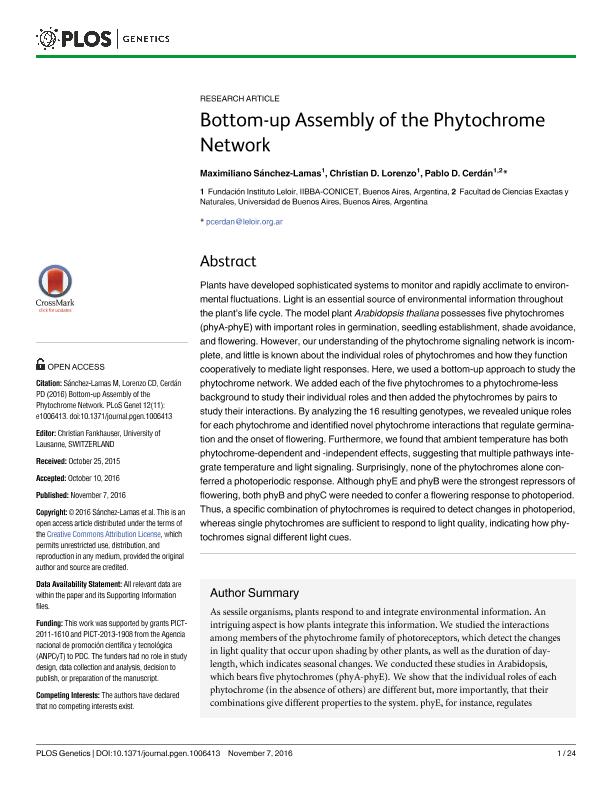Mostrar el registro sencillo del ítem
dc.contributor.author
Sanchez Lamas, Maximiliano

dc.contributor.author
Lorenzo, Christian Damián

dc.contributor.author
Cerdan, Pablo Diego

dc.date.available
2018-10-01T17:46:42Z
dc.date.issued
2016-11
dc.identifier.citation
Sanchez Lamas, Maximiliano; Lorenzo, Christian Damián; Cerdan, Pablo Diego; Bottom-up Assembly of the Phytochrome Network; Public Library of Science; Plos Genetics; 12; 11; 11-2016
dc.identifier.issn
1553-7390
dc.identifier.uri
http://hdl.handle.net/11336/61385
dc.description.abstract
Plants have developed sophisticated systems to monitor and rapidly acclimate to environmental fluctuations. Light is an essential source of environmental information throughout the plant’s life cycle. The model plant Arabidopsis thaliana possesses five phytochromes (phyA-phyE) with important roles in germination, seedling establishment, shade avoidance, and flowering. However, our understanding of the phytochrome signaling network is incomplete, and little is known about the individual roles of phytochromes and how they function cooperatively to mediate light responses. Here, we used a bottom-up approach to study the phytochrome network. We added each of the five phytochromes to a phytochrome-less background to study their individual roles and then added the phytochromes by pairs to study their interactions. By analyzing the 16 resulting genotypes, we revealed unique roles for each phytochrome and identified novel phytochrome interactions that regulate germination and the onset of flowering. Furthermore, we found that ambient temperature has both phytochrome-dependent and -independent effects, suggesting that multiple pathways integrate temperature and light signaling. Surprisingly, none of the phytochromes alone conferred a photoperiodic response. Although phyE and phyB were the strongest repressors of flowering, both phyB and phyC were needed to confer a flowering response to photoperiod. Thus, a specific combination of phytochromes is required to detect changes in photoperiod, whereas single phytochromes are sufficient to respond to light quality, indicating how phytochromes signal different light cues.
dc.format
application/pdf
dc.language.iso
eng
dc.publisher
Public Library of Science

dc.rights
info:eu-repo/semantics/openAccess
dc.rights.uri
https://creativecommons.org/licenses/by-nc-sa/2.5/ar/
dc.subject
Phytochrome
dc.subject
Light
dc.subject
Shade
dc.subject
Photorreceotor
dc.subject.classification
Otras Ciencias Biológicas

dc.subject.classification
Ciencias Biológicas

dc.subject.classification
CIENCIAS NATURALES Y EXACTAS

dc.title
Bottom-up Assembly of the Phytochrome Network
dc.type
info:eu-repo/semantics/article
dc.type
info:ar-repo/semantics/artículo
dc.type
info:eu-repo/semantics/publishedVersion
dc.date.updated
2018-10-01T15:57:11Z
dc.journal.volume
12
dc.journal.number
11
dc.journal.pais
Estados Unidos

dc.journal.ciudad
San Francisco
dc.description.fil
Fil: Sanchez Lamas, Maximiliano. Consejo Nacional de Investigaciones Científicas y Técnicas. Oficina de Coordinación Administrativa Parque Centenario. Instituto de Investigaciones Bioquímicas de Buenos Aires. Fundación Instituto Leloir. Instituto de Investigaciones Bioquímicas de Buenos Aires; Argentina
dc.description.fil
Fil: Lorenzo, Christian Damián. Consejo Nacional de Investigaciones Científicas y Técnicas. Oficina de Coordinación Administrativa Parque Centenario. Instituto de Investigaciones Bioquímicas de Buenos Aires. Fundación Instituto Leloir. Instituto de Investigaciones Bioquímicas de Buenos Aires; Argentina
dc.description.fil
Fil: Cerdan, Pablo Diego. Consejo Nacional de Investigaciones Científicas y Técnicas. Oficina de Coordinación Administrativa Parque Centenario. Instituto de Investigaciones Bioquímicas de Buenos Aires. Fundación Instituto Leloir. Instituto de Investigaciones Bioquímicas de Buenos Aires; Argentina. Universidad de Buenos Aires. Facultad de Ciencias Exactas y Naturales; Argentina
dc.journal.title
Plos Genetics

dc.relation.alternativeid
info:eu-repo/semantics/altIdentifier/doi/https://doi.org/10.1371/journal.pgen.1006413
dc.relation.alternativeid
info:eu-repo/semantics/altIdentifier/url/https://journals.plos.org/plosgenetics/article?id=10.1371/journal.pgen.1006413
Archivos asociados
